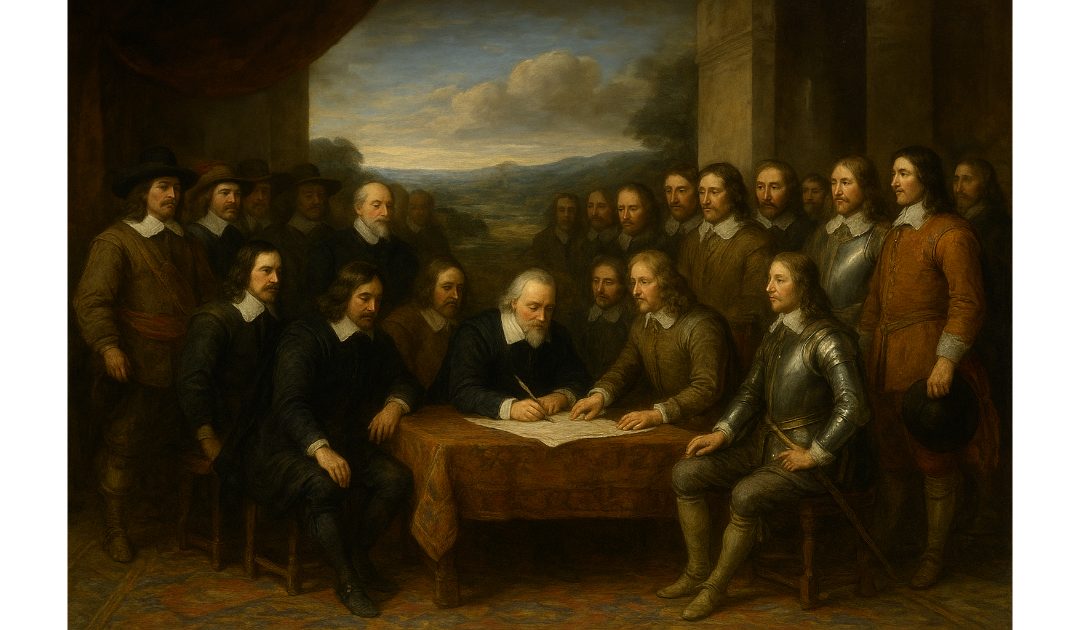The Peace of Westphalia was signed on the 24th of October, 1648, bringing to an end both the Thirty Years’ War and the Eighty Years’ War. Regular readers will know that the Eighty Years’ War was my ancestor, Sir Anthony Standen’s war. He spied for Walsingham against the Spanish in Flanders. I have researched the period whilst writing the Sir Anthony Standen’s Adventures. But I know less about the Thirty Years’ War.
The Thirty Years’ War was rooted in religious tensions within the Holy Roman Empire, though it evolved into a broader conflict involving many European powers vying for political dominance. The war began with the Defenestration of Prague in 1618, an event where Protestant nobles threw two Catholic officials out of a castle window, symbolising the deep sectarian divisions within the empire.
Initially a struggle between Catholic and Protestant states within the empire, the conflict soon attracted external powers, including Spain, France, Sweden, and Denmark, each pursuing their strategic interests. The war is traditionally divided into four phases: the Bohemian, Danish, Swedish, and French phases, each reflecting shifts in alliances and objectives.
The war devastated much of Central Europe. Massive civilian casualties resulted from not only battles but also famine, disease, and the widespread destruction of property. Economically and socially, the Holy Roman Empire suffered immense losses; entire regions were depopulated, and agricultural production collapsed.
Concluding both wars, the Treaty of Westphalia comprised a series of agreements signed in the Westphalian cities of Münster and Osnabrück. The treaty’s negotiators represented a broad spectrum of European powers, reflecting the conflicts’ wide-reaching impact. Notably, the peace talks introduced a new diplomatic model involving multilateral negotiations, setting a precedent for future international diplomacy.
Key provisions of the Treaty of Westphalia included:
- Religious Settlement: The treaty reaffirmed the principle of cuius regio, eius religio, allowing rulers to determine their states’ official religions. However, it also granted greater religious toleration to minority faiths, particularly within the Holy Roman Empire, seeking to mitigate sectarian tensions.
- Territorial Adjustments: Significant territorial changes were enacted. France gained territories in Alsace, Sweden acquired parts of Pomerania and control over key Baltic ports, and the independence of the Swiss Confederacy was formally recognised.
- Sovereignty of States: Perhaps the treaty’s most enduring legacy was the establishment of the concept of state sovereignty. It acknowledged the autonomy of the various principalities, duchies, and kingdoms within the Holy Roman Empire, effectively curtailing the emperor’s authority and decentralising power.
- Recognition of the Dutch Republic: The treaty formally recognised the independence of the Dutch Republic from Spanish rule, ending the Eighty Years’ War and solidifying the Netherlands’ status as an independent, prosperous nation.
The Treaty of Westphalia is often regarded as the foundation of the modern international order. By codifying principles of territorial sovereignty and non-interference, it laid the groundwork for the nation-state system that dominates global politics today. The concept of equal legal status for states, regardless of their size or power, emerged from these agreements.
Economically, the post-war period saw the decline of Spanish influence and the rise of France and the Dutch Republic. France, under the leadership of Cardinal Mazarin and later Louis XIV, began to assert itself as Europe’s preeminent power. The Dutch Golden Age flourished, marked by advancements in trade, science, and the arts.
Socially and culturally, the wars and the treaty fostered a gradual shift towards secular governance. While religion remained influential, the idea that political legitimacy could be derived from secular authority gained traction, diminishing the universal power once held by the Catholic Church.

